Public Ivy
"Public Ivy" is a term coined by author Richard Moll in his book Public Ivies: A Guide to America's Best Public Undergraduate Colleges and Universities (1985) to refer to universities in the United States that are said to provide an Ivy League collegiate experience at a public university price.[1] The Public Ivies, according to The Journal of Blacks in Higher Education, are capable of "successfully competing with the Ivy League schools in academic rigor ... attracting superstar faculty and in competing for the best and brightest students of all races."[2] An expanded list of 30 colleges and universities was provided by Howard and Matthew Greene in their 2001 book The Public Ivies: America's Flagship Public Universities.[3]
Origin of the term
Moll, who earned his Master of Divinity degree from Yale University in 1959,[4] was an admissions officer at Yale and the director of admissions at Bowdoin College, University of California, Santa Cruz, and Vassar College.[4][5][6] He traveled the nation examining higher education and identified eight public institutions (the same as the number of Ivy League members) that he thought had the look and feel of an Ivy League university. In addition to academic excellence, other factors considered by Moll include appearance, age, and school traditions.[7]
Moll's list of Public Ivies (1985)
- College of William & Mary (Williamsburg, Virginia)
- Miami University (Oxford, Ohio)
- University of California (nine campuses as of 1985)
- University of Michigan (Ann Arbor)
- University of North Carolina at Chapel Hill
- University of Texas at Austin
- University of Vermont (Burlington)
- University of Virginia (Charlottesville)
Worthy runners-up
Moll also offered in the same book "a list of worthy runners-up":[8]
- University of Colorado Boulder
- Georgia Institute of Technology (Atlanta)
- University of Illinois at Urbana–Champaign
- New College of Florida (Sarasota; formerly New College of the University of South Florida, it became an independent part of Florida's State University System in 2001)
- Pennsylvania State University at University Park
- University of Pittsburgh (Pitt)
- State University of New York at Binghamton (now branded as Binghamton University)
- University of Washington (Seattle)
- University of Wisconsin–Madison
 The Wren Building at the College of William & Mary
The Wren Building at the College of William & Mary
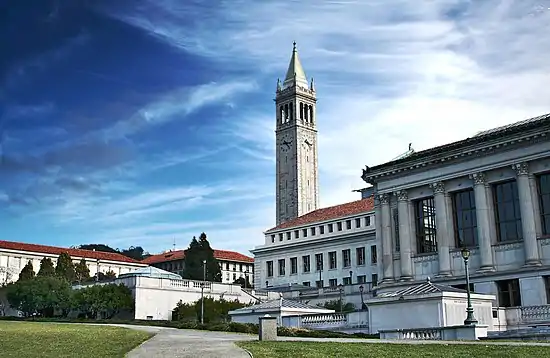 Sather Tower seen from Memorial Glade of the University of California, Berkeley
Sather Tower seen from Memorial Glade of the University of California, Berkeley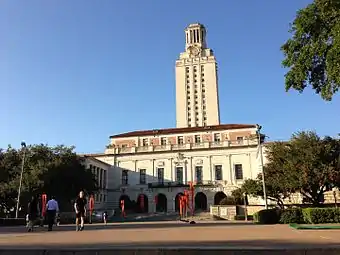 The Main Building at the University of Texas at Austin
The Main Building at the University of Texas at Austin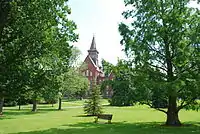 Old Mill at the University of Vermont.
Old Mill at the University of Vermont.
Greenes' Guides list (2001)
The 2001 book The Public Ivies: America's Flagship Public Universities by Howard and Matthew Greene of Greenes' Guides included 30 colleges and universities.[3]
- Northeastern
- Pennsylvania State University (University Park)
- Rutgers University (New Brunswick)
- State University of New York at Binghamton (also known as Binghamton University)
- University of Connecticut (Storrs)
- Mid-Atlantic
- Southern
- Western
- University of Arizona (Tucson)
- University of California, Berkeley
- University of California, Davis
- University of California, Irvine
- University of California, Los Angeles
- University of California, San Diego
- University of California, Santa Barbara
- University of Colorado Boulder
- University of Washington (Seattle)
- Great Lakes & Midwest
- Indiana University (Bloomington)
- Miami University (Oxford, Ohio)
- Michigan State University (East Lansing)
- The Ohio State University (Columbus)
- University of Illinois (Urbana–Champaign)
- University of Iowa (Iowa City)
- University of Michigan (Ann Arbor)
- University of Minnesota (Minneapolis–Saint Paul)
- University of Wisconsin (Madison)
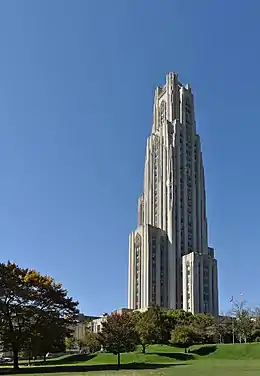 The Cathedral of Learning at the University of Pittsburgh, the tallest educational building in the Western Hemisphere
The Cathedral of Learning at the University of Pittsburgh, the tallest educational building in the Western Hemisphere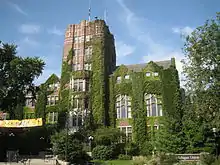


See also
References and sources
Citations
- Richard Moll in his book Public Ivys: A Guide to America's best public undergraduate colleges and universities (1985)
- "Comparing Black Enrollments at the Public Ivies". The Journal of Blacks in Higher Education. Autumn 2005. Retrieved 2006-09-03.
- Greene, Howard R.; Greene, Matthew W. (2001). The public ivies: America's flagship public universities (1st ed.). New York: Cliff Street Books. ISBN 978-0060934590.
- Branch, Mark Alden (November 2000). "Deciphering the Admissions Map". Yale Alumni Magazine. 109 (11). Archived from the original on 2008-01-07. Retrieved 2008-02-09.
¶16: But Richard Moll '59MDiv, a former Yale admissions officer who later oversaw admissions at Bowdoin and Vassar, thinks Yale still is not as visible as it should be. "Yale has not had the presence at grassroots admissions and counseling conferences that Harvard and Stanford have," says Moll, author of Playing the Selective College Admissions Game.
- Pierce, Kenneth M. (24 November 1980). "Dr. Fix-It Goes to Santa Cruz". Time. Retrieved 2008-02-09.
Trouble in paradise as "the touchy-feely school" sings the blues – Richard Moll, 45, a tweedy graduate of Yale's Divinity School, has become a Dr. Fix-It for colleges that complain of sagging enrollment.
- Paul Marthers, Dean of Admission. "Admissions Messages vs. Admissions Realities". Office of Admissions. Reed College. Archived from the original on 2008-02-21. Retrieved 2008-02-09.
- Savage, David G. (1985-10-06). "The Public Ivys: A Guide to America's Best Public Undergraduate Colleges and Universities". Los Angeles Times. ISSN 0458-3035. Retrieved 2016-07-26.
- Moll, Richard (1985). The Public Ivys: A Guide to America's Best Undergraduate Colleges and Universities. Viking Penguin Inc., p. xxvi. ISBN 0-670-58205-0
General sources
- Greene, Howard; Matthew Greene (2001). The Public Ivies: America's Flagship Public Universities. New York: HarperCollins. ISBN 0-06-093459-X.
- Greene, Howard; Matthew Greene (2000). Hidden Ivies: Thirty Colleges of Excellence. New York: HarperCollins. ISBN 0-06-095362-4.
- Moll, Richard (1985). The Public Ivies: A Guide to America's best public undergraduate colleges and universities. New York: Penguin (Viking). ISBN 0-14-009384-2.
